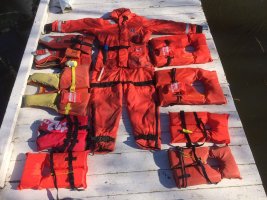saltandthesea
Junior Member
A few useful safety resources...
I'm just getting into this stuff in the SF Bay Area with my Ericson 35-2.
The thing that's been most helpful so far in thinking about safety is a two day US Sailing safety at sea course. Take the two-day version for offshore, which involves a practical component of jumping into the water, deploying your PFD, entering a life raft, righting a life raft, and practice with flares. The class at San Francisco Yacht Club taught by http://www.racingyachtmanagement.com/isaf.php (list to course description and various resources) was very well taught.
US Sailing offers a book to complement the course. Here is a link to a free book by some other rather reputable folks: http://honeynav.com/wp-content/uploads/2016/01/Safety-At-Sea-Core-Topics-Handbook15.pdf
Going through the list, I find it useful to outsource some of the thinking to the local Ocean Yacht Racing Association. The Northern California YRA has a great list of regulations with locally relevant amendments: http://norcalorc.org/ . This page links to a PDF and Excel version (make sure to filter so that both offshore and coastal items show up) with a full list of safety requirements.
Finally, it seems useful to analyze past mishaps and accident reports for learnings and to visualize alternative outcomes and courses of actions. With that, here's a link tot he Yachting Monthly Crash Test Boat series: https://www.youtube.com/watch?v=DPb5AV7BaD4&list=PLKUg-wF-eKBw0w5OR6SpBt6sjD6XMdY7a
Fair seas!
I'm just getting into this stuff in the SF Bay Area with my Ericson 35-2.
The thing that's been most helpful so far in thinking about safety is a two day US Sailing safety at sea course. Take the two-day version for offshore, which involves a practical component of jumping into the water, deploying your PFD, entering a life raft, righting a life raft, and practice with flares. The class at San Francisco Yacht Club taught by http://www.racingyachtmanagement.com/isaf.php (list to course description and various resources) was very well taught.
US Sailing offers a book to complement the course. Here is a link to a free book by some other rather reputable folks: http://honeynav.com/wp-content/uploads/2016/01/Safety-At-Sea-Core-Topics-Handbook15.pdf
Going through the list, I find it useful to outsource some of the thinking to the local Ocean Yacht Racing Association. The Northern California YRA has a great list of regulations with locally relevant amendments: http://norcalorc.org/ . This page links to a PDF and Excel version (make sure to filter so that both offshore and coastal items show up) with a full list of safety requirements.
Finally, it seems useful to analyze past mishaps and accident reports for learnings and to visualize alternative outcomes and courses of actions. With that, here's a link tot he Yachting Monthly Crash Test Boat series: https://www.youtube.com/watch?v=DPb5AV7BaD4&list=PLKUg-wF-eKBw0w5OR6SpBt6sjD6XMdY7a
Fair seas!


